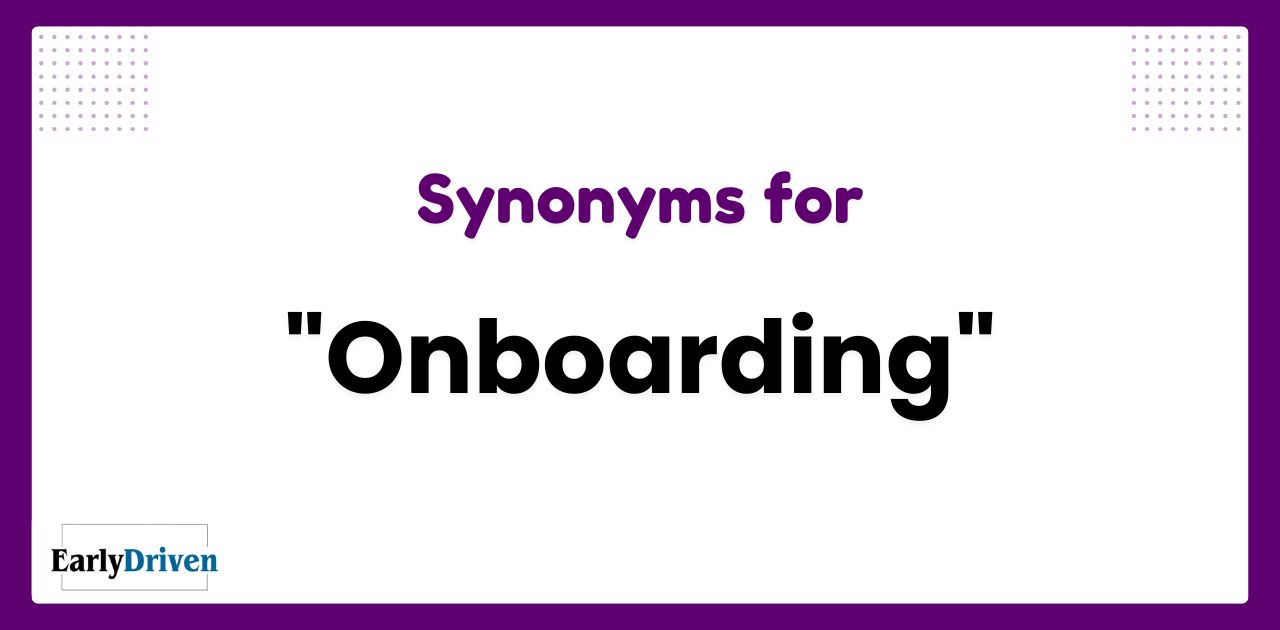Understanding the Purpose of Ways to Say “Onboarding”
In today’s dynamic business environment, the process of integrating new employees into an organization extends far beyond simple paperwork and introductions. The term “onboarding” encompasses a strategic approach to welcoming and acclimating new talent, but organizations often seek alternative phrases that better reflect the nuanced aspects of this crucial process.
This comprehensive guide explores twenty professional alternatives to “onboarding,” each offering unique perspectives on the integration journey.
Synonyms for “Onboarding”
- Employee Integration
- Staff Induction
- Employee Enrollment
- Workforce Assimilation
- Staff Onboarding Process
- Employee Transition
- Job Familiarization
- Team Orientation
- Resource Alignment
- Personnel Introduction
- Talent Welcome
- Workforce Engagement
- Accomplishment
- New Hire Orientation
- Newcomer Program
- Taking advantage of
- New Employee Training
- Taking on
- Acceptance
- Adding to payroll
1. Employee Integration
Employee integration represents a holistic approach to incorporating new team members into an organization’s ecosystem. This term emphasizes the importance of cultural alignment and operational familiarity.
Example: “Our employee integration program at TechCorp includes a three-month structured plan where new hires collaborate with different departments to understand cross-functional workflows. For instance, software developers spend time with the customer success team to gain firsthand insights into user experiences.”
2. Staff Induction
Staff induction focuses on the formal introduction of employees to organizational protocols and values. This systematic approach ensures comprehensive coverage of essential information.
Example: “During the two-week staff induction at Global Healthcare, new nurses shadow experienced practitioners while learning hospital protocols. This includes hands-on training with electronic health records and participation in interdepartmental rounds.”
3. Employee Enrollment
Employee enrollment emphasizes the administrative and systematic aspects of bringing new team members aboard. This term particularly relates to the formal registration and documentation process.
Example: “The employee enrollment process at FinTech Solutions includes digital documentation submission, benefits selection, and system access setup, typically completed within the first 48 hours.”
4. Workforce Assimilation
Workforce assimilation represents a strategic approach to helping new employees become fully integrated members of the organizational community. This process focuses on both professional and cultural adaptation.
Example: “At Global Innovations, the workforce assimilation program includes monthly cross-departmental projects where new hires collaborate with veteran employees. Recently, a new marketing analyst partnered with the sales team to develop customer journey maps, accelerating their understanding of company operations.”
5. Staff Onboarding Process
The staff onboarding process encompasses the systematic steps organizations take to transform new hires into productive team members. This structured approach ensures consistent integration across all departments.
Example: “MediaTech’s staff onboarding process incorporates a digital learning platform where new employees complete interactive modules while receiving real-time feedback from their managers. This includes scenario-based training specific to their role.”
6. Employee Transition
Employee transition focuses on the gradual shift from new hire to fully integrated team member. This term emphasizes the journey aspect of joining an organization.
Example: “The employee transition at ConsultCo spans six months, during which new consultants progress through defined milestone projects. Each consultant receives weekly mentoring sessions and participates in client-facing activities with increasing responsibility.”
7. Job Familiarization
Job familiarization emphasizes the practical aspects of role adaptation and skill development. This approach prioritizes hands-on experience and technical proficiency.
Example: “During the eight-week job familiarization period at Manufacturing Plus, new production engineers rotate through different assembly lines, gaining practical experience with various equipment and processes.”
8. Team Orientation
Team orientation highlights the collaborative aspects of integration, focusing on building relationships and understanding team dynamics.
Example: “The accounting department at Finance Corp implements a team orientation program where new hires participate in weekly team lunches and collaborative problem-solving sessions, fostering natural connections with colleagues.”
Read Also: 20 Synonyms for “Best Wishes” in an Email
9. Resource Alignment
Resource alignment ensures new employees have access to necessary tools, knowledge, and support systems for success in their roles.
Example: “Tech Solutions’ resource alignment process includes personalizing technology setups, providing role-specific software training, and establishing connections with key stakeholders within the first week.”
10. Personnel Introduction
Personnel introduction focuses on formally welcoming new employees and facilitating meaningful connections across the organization.
Example: “At Healthcare Partners, new medical staff undergo a comprehensive personnel introduction program, including shadowing opportunities with various departments and attendance at interdisciplinary team meetings.”
11. Talent Welcome
Talent welcome emphasizes creating a positive first impression and establishing a foundation for long-term engagement.
Example: “Investment firm Goldman & Associates implements a talent welcome program where senior leaders personally greet new hires and share insights about the company’s culture and vision during their first week.”
12. Newcomer Program
The newcomer program provides a structured approach to welcoming and integrating new employees while emphasizing personal growth and development.
Example: “StartupTech’s newcomer program pairs each new hire with a ‘culture buddy’ who helps them navigate both formal processes and informal company norms over their first quarter.”
13. Workforce Engagement
Workforce engagement emphasizes the ongoing process of connecting new employees with their roles, colleagues, and organizational mission. This approach focuses on building lasting commitment and enthusiasm.
Example: “At Innovation Labs, the workforce engagement strategy includes quarterly innovation challenges where new employees collaborate with different teams to solve real business problems. Recently, a new product developer partnered with marketing to create a customer feedback implementation system that improved product iterations.”
14. Accomplishment
The accomplishment approach frames the integration process as a series of meaningful achievements and milestones. This perspective helps new hires recognize their progress and growing contribution to the organization.
Example: “ConsultingPro’s accomplishment framework includes structured projects of increasing complexity. New consultants begin with internal analysis projects before progressing to client-facing assignments, celebrating key achievements at each stage.”
15. New Hire Orientation
New hire orientation provides a comprehensive introduction to organizational systems, policies, and culture. This foundational approach ensures all new employees start with essential knowledge and resources.
Example: “At Global Bank, the two-week new hire orientation combines virtual learning modules with hands-on practice sessions. New financial analysts participate in simulated trading scenarios while learning about compliance requirements and risk management protocols.”
16. Taking Advantage Of
The “taking advantage of” approach emphasizes maximizing available resources and opportunities during the integration period. This strategy focuses on optimal utilization of learning and development resources.
Example: “TechStart encourages new employees to take advantage of their first 90 days by participating in cross-functional projects, attending skill-building workshops, and utilizing the company’s extensive online learning library.”
17. New Employee Training
New employee training focuses on developing role-specific skills and knowledge through structured learning experiences. This comprehensive approach combines theoretical knowledge with practical application.
Example: “Manufacturing Excellence implements a three-month new employee training program where production specialists rotate through different manufacturing processes, combining classroom instruction with hands-on equipment operation experience.”
18. Taking On
The “taking on” approach emphasizes gradual assumption of responsibilities and ownership of projects. This method allows new hires to build confidence while developing competence.
Example: “At Legal Partners, new associates begin by taking on research assignments before progressively handling client consultations and case management, with senior attorney oversight decreasing as competency increases.”
19. Acceptance
Acceptance focuses on the mutual process of integration between new employees and existing teams. This approach emphasizes building trust and establishing productive working relationships.
Example: “Digital Solutions facilitates acceptance through collaborative projects where new team members contribute their fresh perspectives while learning from experienced colleagues’ insights. A recent example involved a new UX designer collaborating with senior developers to redesign a key product feature.”
20. Adding to Payroll
While “adding to payroll” traditionally focuses on administrative processes, modern organizations expand this concept to include comprehensive integration into company systems and benefits structures.
Example: “FinTech Solutions has transformed their adding to payroll process into a holistic experience that combines administrative setup with benefits education and financial wellness resources. New employees receive personalized guidance on optimizing their compensation package and understanding available benefits.”
Read Also: 15 Synonyms for “Nice-to-Have”
Best Practices for Professional Integration
- Create structured timelines for each phase
- Implement mentorship programs
- Establish clear communication channels
- Set measurable integration milestones
- Gather regular feedback from new hires
Examples of Scenarios Where Integration Methods Matter
Corporate Mergers
When Company A acquires Company B, the integration process might involve:
- Cultural alignment workshops
- System harmonization training
- Team building exercises
- Cross-functional project assignments
Remote Worker Integration
For virtual team members, consider:
- Virtual orientation sessions
- Digital resource libraries
- Online mentoring programs
- Regular video check-ins
FAQ’s
Q: How long should the integration process last?
A: While initial orientation typically spans 1-2 weeks, comprehensive integration often extends 3-6 months, depending on role complexity and organizational size.
Q: What is onboarding in simple words?
A: Onboarding is the structured process of integrating new employees into an organization, including orientation, training, and cultural adaptation to help them become productive team members.
Q: What is another term for onboarding?
A: Common alternatives include employee integration, staff induction, and new hire orientation, with each term emphasizing different aspects of the integration process.
Q: What is a catchy name for onboarding programs?
A: Modern organizations use engaging names like “Talent Welcome Journey,” “Integration Excellence,” or “New Hire Success Path” to make their onboarding programs more appealing and memorable.
Q: What is onboarding job term?
A: In professional contexts, onboarding refers to the comprehensive process of familiarizing new employees with their roles, responsibilities, and the organization’s culture during their initial employment period.
Q: What is the vocabulary of onboarding?
A: The onboarding vocabulary includes terms like integration, orientation, assimilation, induction, and employee enrollment, each highlighting specific aspects of the new hire integration process.
Q: What is another word for new client onboarding?
A: Professional alternatives include client integration, account initiation, service commencement, or client welcome program, depending on the industry and service context.
Q: How would you best describe your onboarding?
A: An effective onboarding program is a structured, comprehensive process that combines administrative tasks, role-specific training, cultural integration, and relationship building to ensure new hire success.
Q: Is onboarding a business jargon?
A: While onboarding originated as business terminology, it has become a widely accepted professional term describing the systematic process of integrating new employees into an organization.
Q: What is another name for employee orientation?
A: Alternative terms include staff induction, new hire welcome program, workforce integration, or personnel introduction program, each emphasizing the initial phase of employee integration.
Q: What is a better way to say onboarding?
A: Professional alternatives include employee integration, talent welcome, workforce assimilation, or staff induction, depending on the specific aspects of the process you want to emphasize.
Conclusion
The evolution of workplace dynamics has transformed how organizations welcome and integrate new talent. By understanding and appropriately utilizing these twenty alternatives to “onboarding,” organizations can create more effective and engaging integration experiences. The key lies in selecting terminology that aligns with company culture while effectively communicating the comprehensive nature of the integration process.
Elevate you English Learning Skills with our Mastery Blogs!

“Smith, At EarlyDriven, our dedicated team of experienced writers and journalists brings you comprehensive coverage across entertainment, celebrity news, and educational content. With expertise in digital media and a commitment to accuracy, we craft engaging stories that inform, educate, and entertain our global readership.










